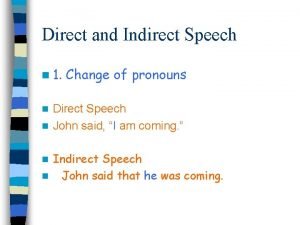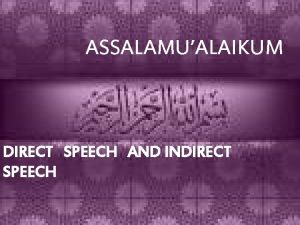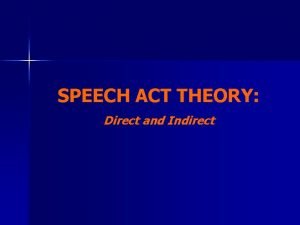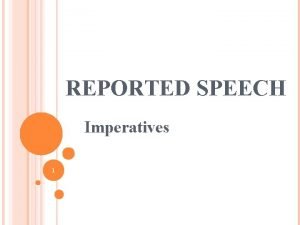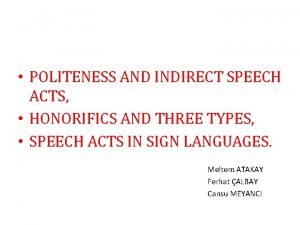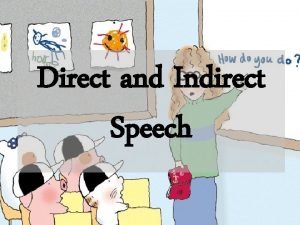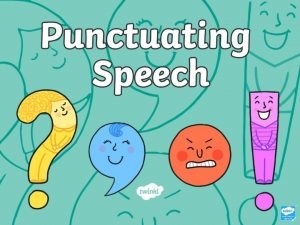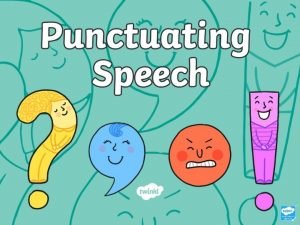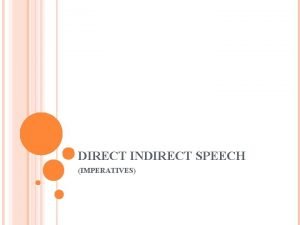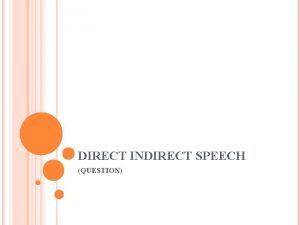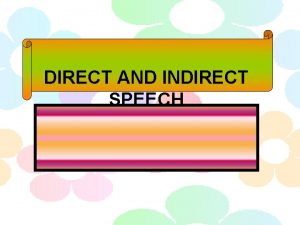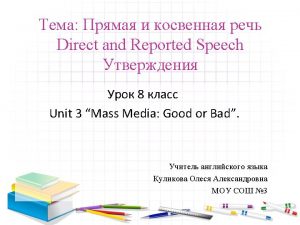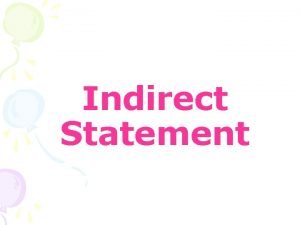DIRECT INDIRECT SPEECH STATEMENT DIRECT SPEECH Direct speech










- Slides: 10

DIRECT INDIRECT SPEECH (STATEMENT)

DIRECT SPEECH → Direct speech refers to reproducing another person’s exact words. → We use quotation marks when we quote a speaker’s words. Example: v Jane said, “Cats are fun to watch. ” v Ann said, “My sister is a student. ” v John said, “My book is on the table. ”

EXAMPLE Ann said, “My book is on the table. ” Comma Statement Reporting Verb Quotation Mark

DIRECT SPEECH VS INDIRECT SPEECH Direct Speech Indirect Speech Reproducing another person’s exact words. Quotation marks are used. Ann said, “I am hungry. ” Tom said, “I need my pen. ” Reproducing the idea of another person’s words. Not all of the exact words are used: verb forms and pronouns may change. Quotation marks are not used. Ann said that she was hungry. Tom said that he needed his pen.

IF THE REPORTING VERB IN THE FORM OF PRESENT, PRESENT PERFECT AND FUTURE No need to change the tense v Pronoun changes v Adverb of time doesn’t change Example: 1. Ann says, “My book is on the table. ” Ann says that her book is on the table. 2. Jane has said, “My sister is a student. ” Jane has said that her sister is a student. 3. Tom will say, “I need my pen. ” Tom will say that he needs his pen. v

IF THE REPORTING VERB IN THE FORM OF PAST Need to change the tense Pronoun changes Adverb of time changes Example: 1. He said, “I work hard. ” He said that he worked hard. 2. Jennie said, “I went to a doctor yesterday. ” Jennie said that she had gone to a doctor the day before.

VERBS CHANGE Simple Present Kate said, “I eat my lunch. ” Present Continuous Kate said, “I am eating my lunch. ” Simple Present Past Perfect Kate said, “I have eaten my lunch. ” Past Kate said that she ate her lunch. Past Continuous Kate said that she was eating her lunch. Perfect Kate said that she had eaten her lunch.

Simple Past MODAL 1. Kate said, “I can eat my lunch. ” 2. Kate said, “I may eat my lunch. ” 1. Kate said that she could eat her lunch. 2. Kate said that she might eat her lunch. Past Kate said, “I ate my lunch. ” Future Kate said, “I will eat my lunch. ” Perfect Kate said that she had eaten her lunch. Past Future Kate said that she would eat her lunch.

3. Kate said, “I have to eat my lunch. ” 3. Kate said that she had to eat her lunch. 4. Kate said, “I must eat 4. Kate said that she my lunch. ” had to eat her lunch. 5. Kate said, “I should eat my lunch. ” 5. Kate said that she should eat her lunch. 6. Kate said, “I ought to eat my lunch. ” 6. Kate said that she ought to eat her lunch.

EXPRESSIONS OF TIME AND PLACE DIRECT Today Yesterday Next week Last week A week ago Now This here INDIRECT That day The day before The following week The previous week A week before Then That there
 Reported speech adverbs
Reported speech adverbs Reported speech wh questions
Reported speech wh questions Assalamualaikum images
Assalamualaikum images Kinds of sentence
Kinds of sentence Direct and indirect speech worksheet
Direct and indirect speech worksheet Reported speech imperative examples
Reported speech imperative examples Direct or indirect speech act
Direct or indirect speech act Learning objectives of direct and indirect speech
Learning objectives of direct and indirect speech Reported speech tutorial
Reported speech tutorial Rules for speech punctuation
Rules for speech punctuation Inverted commas
Inverted commas

